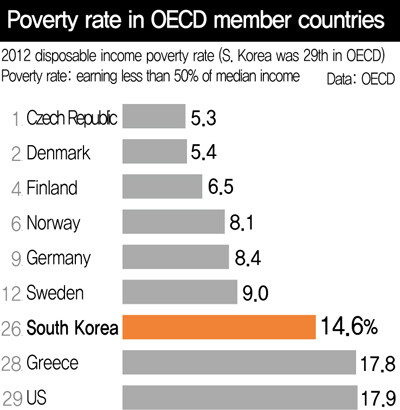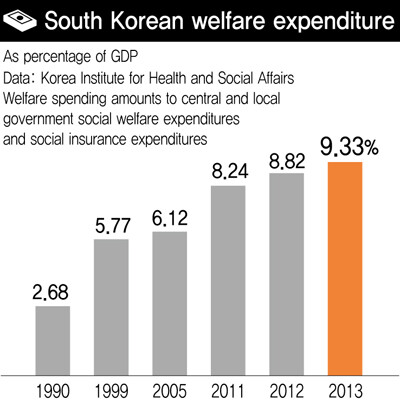hankyoreh
Links to other country sites 다른 나라 사이트 링크
Reports: government welfare spending and allocation still inadequate
South Korean spending on public and social welfare amounted to 9.33% of gross domestic product in 2013, while the welfare and taxation system has fallen severely short in relieving poverty and inequality.
These were among the findings in a report titled 2013 South Korean Social Welfare Expenditures written last year by the Korea Institute for Health and Social Affairs (KIHASA) commissioned by the Ministry of Health and Welfare. The ministry and KIHASA plan to officially submit the results to the Organization for Economic Cooperation and Development (OECD) next month.
Public and social welfare spending yet to pass 10% of GDP

According to the KIHASA report, South Korean public and social welfare spending for 2013 totaled 133.4 trillion won (US$108.7 billion), or 9.33% of GDP. The rate was up 0.51 percentage points from the year before, but still hovered below the 10% of GDP mark. The 2012 average for other OECD countries stood at 21.6%.
In the past, the South Korean government has announced public and social welfare spending rates of 9.6% of GDP in 2012 and 10.2% in 2013, with a projected 10.4% rate for 2014. The figures in the KIHASA report were the result of a new analysis using the manual and then altered to conform to OECD standards.
A detailed breakdown of public and social welfare spending showed 51 trillion won (US$41.6 billion) in general central and local government social welfare expenditures and 81.6 trillion won (US$66.5 billion) in social insurance expenditures, including health insurance and the public pension. Legally prescribed private social welfare expenditures, or the sum of severance pay and retirement pensions, stood at 10.6 trillion won (US$8.6 billion), or 0.74% of GDP. Taken together, the figures show South Korean social welfare expenditures - including public and social welfare spending and legally prescribed private social welfare spending - totaling 144 trillion won (US$117.4 billion), or 10.07% of GDP.
“Public and social welfare spending is a statistic that shows the extent to which the government guarantees against societal risks, but in South Korea that number has yet to pass 10% of GDP,” said KIHASA research Ko Kyung-hwan, who oversaw the analysis.
“If we consider the social services spending demanded by an aging society, it’s clear that we need more active measures to allocate welfare finances,” Ko added.
Welfare and taxation failing to address poverty and inequality
The report also noted that despite tax measures and continued increases in social spending since the foreign exchange crisis of the late ’90s, South Korea‘s current welfare and taxation systems are failing to do much to alleviate inequality or poverty. The Gini coefficient - a measure that rates income inequality on a scale from zero to one, with higher numbers indicating greater inequality - was calculated at 0.338 for market income in terms of the 2012 median household income. For disposable income, or market income with taxes and social insurance premiums subtracted and the welfare benefits like the basic or national pension added in, the number was 0.307. The difference of just 0.031 percentage points between the values for market and disposable income mean that the social service and tax systems haven’t contributed significantly to relieving inequality. In advanced economies, market income inequality is greatly reduced through the social service and tax systems.
Take Denmark: the country, which ranks first for having the world’s lowest inequality, had a high market income Gini coefficient of 0.436, but the social security system and tax measures there have resulted in a much lower disposable income coefficient of 0.249. The US, in contrast, had both a high market income coefficient of 0.513 and a high disposable income coefficient of 0.39 - making it one of the most unequal countries in the world.
South Korea’s social service and tax systems have also done little to lower the poverty rate. Two values were calculated for the country‘s poverty rate, or the percentage of people earning less than 50% the median income for 2012: a market income poverty rate of 16.5% and a disposable income poverty rate of 14.6%. In other words, the poverty reduction effect from the social service and tax systems amounted to just 1.9 percentage points. The country also ranked 26th out of the 29 countries analyzed for disposable income poverty rate. Sweden had a difference of 17.1 percentage points between the former and latter, Great Britain 20.2 percentage points.
At the Hankyoreh’s request, KIHASA conducted another poverty rate analysis only for the working-age population of those 15 and older. The results were a market income poverty rate of 10% and a disposable income poverty rate of 10.9% - meaning the situation was actually worse. The numbers show that government welfare spending through taxation and the social security system is channeled many toward disadvantaged segments, with little made available to the working poor or other working-age South Koreans.
Senior support ratio expected to skyrocket in four yearsSouth Korea is poised for an explosive rise in its senior citizen support ratio between 2020 and 2030, as the roughly nine million baby boomers born between 1955 and 1964 reach the age of 65. The senior support ratio represents the number of people aged 65 or older for every 100 member of the productive population aged 15 to 64. The 2015 rate stood at 17.9%; in 2020, it is expected to pass 20% for the first time at around 22.2%. By 2030, it is predicted to soar to around 38% - a number that would put it ahead of Sweden (37%), Great Britain (35%), and the US (33.8%).
By Lee Chang-gon, staff reporter
Please direct questions or comments to [english@hani.co.kr]
Editorial・opinion
![[Column] Park Geun-hye déjà vu in Yoon Suk-yeol [Column] Park Geun-hye déjà vu in Yoon Suk-yeol](https://flexible.img.hani.co.kr/flexible/normal/500/300/imgdb/original/2024/0424/651713945113788.jpg) [Column] Park Geun-hye déjà vu in Yoon Suk-yeol
[Column] Park Geun-hye déjà vu in Yoon Suk-yeol![[Editorial] New weight of N. Korea’s nuclear threats makes dialogue all the more urgent [Editorial] New weight of N. Korea’s nuclear threats makes dialogue all the more urgent](https://flexible.img.hani.co.kr/flexible/normal/500/300/imgdb/original/2024/0424/7317139454662664.jpg) [Editorial] New weight of N. Korea’s nuclear threats makes dialogue all the more urgent
[Editorial] New weight of N. Korea’s nuclear threats makes dialogue all the more urgent- [Guest essay] The real reason Korea’s new right wants to dub Rhee a founding father
- [Column] ‘Choson’: Is it time we start referring to N. Korea in its own terms?
- [Editorial] Japan’s rewriting of history with Korea has gone too far
- [Column] The president’s questionable capacity for dialogue
- [Column] Are chaebol firms just pizza pies for families to divvy up as they please?
- [Column] Has Korea, too, crossed the Rubicon on China?
- [Correspondent’s column] In Japan’s alliance with US, echoes of its past alliances with UK
- [Editorial] Does Yoon think the Korean public is wrong?
Most viewed articles
- 1‘We must say no’: Seoul defense chief on Korean, USFK involvement in hypothetical Taiwan crisis
- 2N. Korean delegation’s trip to Iran shows how Pyongyang is leveraging ties with Moscow
- 3Amnesty notes ‘erosion’ of freedom of expression in Korea in annual human rights report
- 4‘Weddingflation’ breaks the bank for Korean couples-to-be
- 5[Reportage] On US campuses, student risk arrest as they call for divestment from Israel
- 6[Column] Park Geun-hye déjà vu in Yoon Suk-yeol
- 7Korea sees more deaths than births for 52nd consecutive month in February
- 8[Editorial] New weight of N. Korea’s nuclear threats makes dialogue all the more urgent
- 9Will NewJeans end up collateral damage in internal feud at K-pop juggernaut Hybe?
- 10[Guest essay] The real reason Korea’s new right wants to dub Rhee a founding father